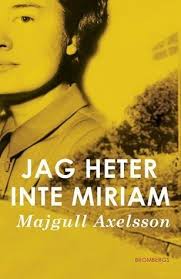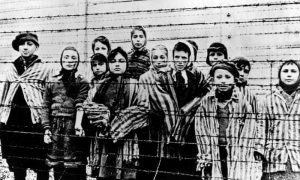Jag heter inte Miriam (My Name is not Miriam), Majgull Axelsson, Sweden, 2015
 On her 85th birthday, Miriam receives a beautiful bracelet from her family. It is handcrafted by gypsies and her name, Miriam, has been carefully engraved into the silver. However, she both amazes and disturbs her family when she announces that her name is not Miriam.
On her 85th birthday, Miriam receives a beautiful bracelet from her family. It is handcrafted by gypsies and her name, Miriam, has been carefully engraved into the silver. However, she both amazes and disturbs her family when she announces that her name is not Miriam.
Miriam’s thoughts revert to the 1940s, and we learn that she is actually a gypsy and that her name is Malika. As we navigate a patchwork of the distant past, the more immediate past and the present, Miriam’s (or Malika’s) story becomes clearer.
With a number of other gypsy children, including her little brother and her cousin, she is taken to a convent where she is well treated. However, when the Nazis decide that gypsies, like the Jews, homosexuals and disabled people (to name but a few), are actually degenerates, she finds herself in Auschwitz. She watches both her cousin and her little brother die and is then selected to be sent to Ravensbrück. On the hellish train trip to Ravensbrück her dress is torn, and wanting to avoid any retribution she changes dresses with a Jewish girl who has died on the trip. The girl’s name is Miriam Goldberg.

With a new, Jewish, identity she sets about trying to survive in an environment where survival is a game of chance with all the odds against her. She discovers, however, that as a Jew, she is held in slightly higher regard than the gypsies in the camp. Also, she has the good fortune to be looked after by a group of Norwegian women, and when the camp is finally liberated in 1945 she finds herself on a Red-Cross bus headed for Sweden.
Sweden’s attitude towards gypsies was not at all positive (gypsies were not permitted to enter the country until 1954), and Miriam chooses to remain as Miriam. This is the lie that she hides for more than sixty years until, on her 85th birthday, she confides in her granddaughter, Camilla, who she really is.
This is not only a story about the horror of the Nazi camps, it is also a story about how the past and the present are intertwined. We can never escape our past; it is always part of us, and it makes us who we are in any given moment. 
Axelsson’s description of the camps where it is possible to see, hear, and even smell, the degradation, the terror and the sadistic violence, is among the most powerful I have read on the subject. Also her description of 1950’s Sweden – from all angles – is to be applauded. Her movement between different time periods and different places, although bewildering at times, works well on the whole. My only criticism would be the focus, in the final pages of the book, on the disruptive and negative relationships within Miriam’s own family. I did not feel that this was necessary, but others may disagree.
Definitely a book to read and reflect over.
The image of Majgull Axelsson is from Göteborgs-Posten
The image of gypsies is from The Guardian